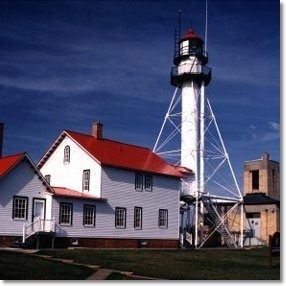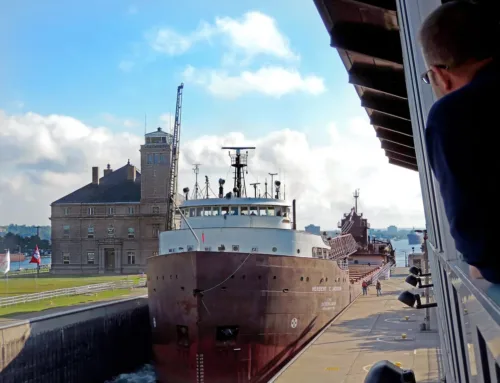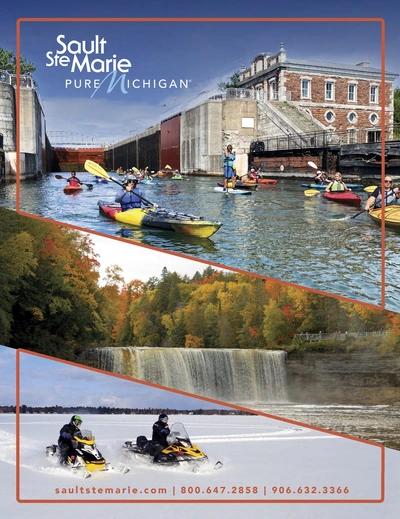Lighthouses of The Great Water of Pure Michigan
Join Jerry and Lucy Smith as make a journey to the Lake Superior Lighthouses.
It was a lighthouse tour de force one Saturday, when we hit the road to visit Lake Superior lights. Follow our journey while we visit Point Iroquois Lighthouse, Whitefish Point Lighthouse and Crisp Point Lighthouse. For more Michigan Lighthouses please visit Michigan Lighthouse Guide.
Point Iroqouis Lighthouse

Point Iroqouis
Heading west on Six Mile Road, it was a short, 25-minute ride to our first love affair – Point Iroquois Lighthouse. Situated high above the waters of Whitefish Bay, this 1870 structure proudly stood 65-feet tall, with two attached buildings.
“This was one of the lighthouses in Michigan where the light keepers could have their families live with them while on duty,” explained Jerry Smith, who with his wife, Lucy, serves as the volunteer caretaker at Point Iroquois. At one point, as many as eight children and three keepers lived on the site, which includes two attached structures. One housed “the boss” with his family and the other provided a home to his two assistants and their kin.
Stepping into the assistant keeper’s quarters was like stepping back into the 1950s, where living space has been re-created, right down to the old-time appliances, radios, and children’s games. A self-guided tour through the museum covered everything from navigational aides to the specific uniforms worn by the light keepers.
A fourth order Fresnel lens flashes proudly in the museum, providing an appropriate stand-in for the one that left Iroquois for the Smithsonian in 1963 when the light was deactivated. A 72-step spiral stairway led to the lamp room and spectacular panoramas of Canada, Whitefish Bay, and Hiawatha National Forest.
The museum, 1950s exhibit and tower all offer free admission and a small but well-appointed bookshop features a great selection of Great Lakes books for children and adults.
Whitefish Point Lighthouse

Back on the road toward our next light, it should be noted that Six Mile Road becomes Lakeshore Drive and later is called Curly Lewis Highway. With each new name, the scenic vistas beside the road become more spectacular. Forest, shoreline, rolling hills and water as far as the eye can see carry us all the way to Paradise, Michigan, where we will make an 11-mile trek north to the most well-know of our three lights –Whitefish Point Light. In 2011, this light celebrated its 150th anniversary.
We are immediately enraptured by a museum that is both haunting and historic, providing irrefutable proof of the adjacent shoreline’s moniker – “The Shipwreck Coast.” Artifacts, photographs, descriptive panels and haunting music all conspire against us, creating an emotional maelstrom for those who can, in their mind’s eye, see families awaiting word of loved ones lost to the perils of Superior. If your imagination is not enough, step into the museum’s theater, where the story of the famous Edmund Fitzgerald is retold in unforgettable detail.
Walking the grounds, traversing the beach, and poking our heads into the gift shop kept us busy for quite some time. To top it off, we learned that the facility had renovated the 1923 Coast Guard Lifeboat Station crew quarters, which now serve as unique lodging.
Crisp Point Lighthouse

A View From the Top of Crisp Point Lighthouse
We strike out toward our third, most-remote light and this one took us down narrow, winding, gravel roads far off the beaten path. As its website said, the journey to Crisp Point Lighthouse really is not a trip – it is an adventure! Located 37 road miles from Paradise, that leg of the trip took a little over an hour, but who can complain when you’re driving on canopy-covered roads past grazing deer and Sand hill cranes.
Crisp Point stands guard over a sugar sand beach on Lake Superior, where a mysterious rumble of moving rock follows each wave that breaks over a narrow bed of stones. With a sense of discovery, my husband asked, “Do you hear that?” We listened intently as we watched rock hounds meticulously search the waterline for prized agates.
“You cannot find stones like these in any other lake except Superior,” explains Larry Farmer, a volunteer weekend host at the light. He and his wife, Dixie, hail from Three Rivers but happily brave an eight-hour drive north every summer to take their turn welcoming visitors to Crisp Point.
There is nothing as far as the eye can see but a wide swath of sand, beach grass, forest, and the unequaled beauty of Lake Superior. A boardwalk allows visitors of all ages enjoy the lighthouse.
On summer weekends, visitors climb stairs to the tower’s lantern and for those unafraid of heights, there is a rare opportunity to walk along the parapet that encircles the lamp room. Although weekday visitors may be disappointed about lack of access to the 58-foot tower is interior, the stunning landscape does not disappoint and what they may lack in height, they will gain in tranquility, as weekday visitors are still rare.
In its prime, Crisp Point was a lifesaving station that included several buildings. Decommissioned in 1993, only the original tower remains, thanks in part to the ferocity that is Lake Superior. The Crisp Point Light Historical Society continues to raise money to preserve and restore some of what has been lost, including the service entrance, which is currently under construction.
As we depart Crisp Point for the 90-mile trek back to Sault Ste. Marie, we remark on the good fortune of a day packed with lighthouses and history and are excited by the prospect of tomorrow, when we explore the remaining lighthouses in the eastern U.P.






